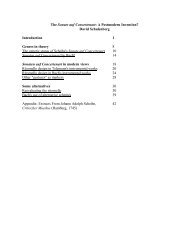SEVEN PAPERS ON EXISTENTIAL ANALYSIS ... - Wagner College
SEVEN PAPERS ON EXISTENTIAL ANALYSIS ... - Wagner College
SEVEN PAPERS ON EXISTENTIAL ANALYSIS ... - Wagner College
Create successful ePaper yourself
Turn your PDF publications into a flip-book with our unique Google optimized e-Paper software.
eyes. That reflection gives me the first glimpses of what I am, yet any mirror image of myself will<br />
always be only a chilly unreal eidolon (the alter ego) of what I am, since the body I see in the<br />
mirror reveals only the body I have and only part of it. My face is the first part of the body I have<br />
of which I am consciousness, and as a result throughout life my face exemplifies my body.<br />
The other validates my existence in the way he looks at me, as well as in the way he<br />
touches me, and by the tone, quality, and manner of the way he speaks to me (7). What is said<br />
matters little at first, even though the content of the speech becomes increasingly important for<br />
what I will be. Its tone quality is significant from the start. Similarly, later in life, someone speaking<br />
to me in a language I do not understand will still validate my existence, even though the<br />
experience may also bring into sharper relief for me what I am.<br />
D. The Body I Am and the Body I Have<br />
I have made a distinction between the body one has and the body one is. What, more<br />
precisely, is meant by this distinction? The parts of my body that I can see and touch with my<br />
own hands and especially my hands themselves, which do the touching, comprise the body I<br />
have. The parts of my body that are hidden from direct view but which can be palpated by me,<br />
or are brought to life in interior feelings of pleasure and pain are also included in the Gestalt of<br />
the body I have. This is the body that has a certain physiognomy and a past.<br />
The body I have is the body I exercise to certain proportions I have envisaged. It is the<br />
body I feed and costume. Finally, it is the body that is scarred and wrinkled, pale or tinted,<br />
made over with cosmetics or reconstructed by surgery. It is the body that is so tall and so heavy,<br />
the body that senses. It eludes my inspection, whether in the reflected image on the surface of a<br />
mirror or on the two-dimensional superfices of a portrait painting or photographic or electronic<br />
image.<br />
The body I have feels what touches it. I am disturbed at the body I have and feel pain or<br />
pleasure there. Pain caused by outside forces as well as endogenous pain are experienced as<br />
attacks "against" the body I have. Occasionally, I may surprise myself and touch a part of the<br />
body I have with a part of the body I am (for example, when I reach for something but<br />
absentmindedly and accidentally grab onto my own arm). In spite of the temporary dislocation,<br />
I immediately revert to being only the body I have (8). In such rare and peculiar perceptions, I<br />
am briefly made aware of my dual body, and therefore implicitly grasp the difference between<br />
what I am and my existence, yet usually the experience does not last long enough to "make a<br />
difference," and, typically, I overlook anomalous perceptions. It was a perceptual error, I say to<br />
myself. If I try to repeat it, in order to verify it, I cannot and feel relieved by the outcome of the<br />
test (9).<br />
What I sense falls into place at once in what I am. It finds a place in my past, a past I am<br />
continually revising. If it is a powerful or otherwise significant. sensation, I may even retrace vast<br />
ranges of my past, looking for where the sensation has a place or context, and in that case the<br />
reorganization of my past that is always determining its possible future will be especially<br />
dramatic.<br />
What I register of what I have sensed must also "make sense" for what I am as the future<br />
my past has. When I cannot organize what I sense with respect to that future, I experience<br />
panic. The ontological anxiety of human living organizes what is sensed with respect to the<br />
future my past has. Heidegger has described this anxiety as one of the equally basic dimensions<br />
of being human.<br />
As we have said, I do not sense my existence. I do not have direct access to my own<br />
existence. Only an other has such access. My existence is nothing I can be, but I can know<br />
about it. I can reflect on my existence "after the fact," so to speak. In reflection, I can form an<br />
image of my presence. As something imagined, pieced together from my encounters with















